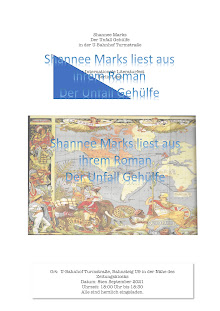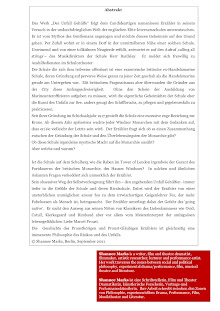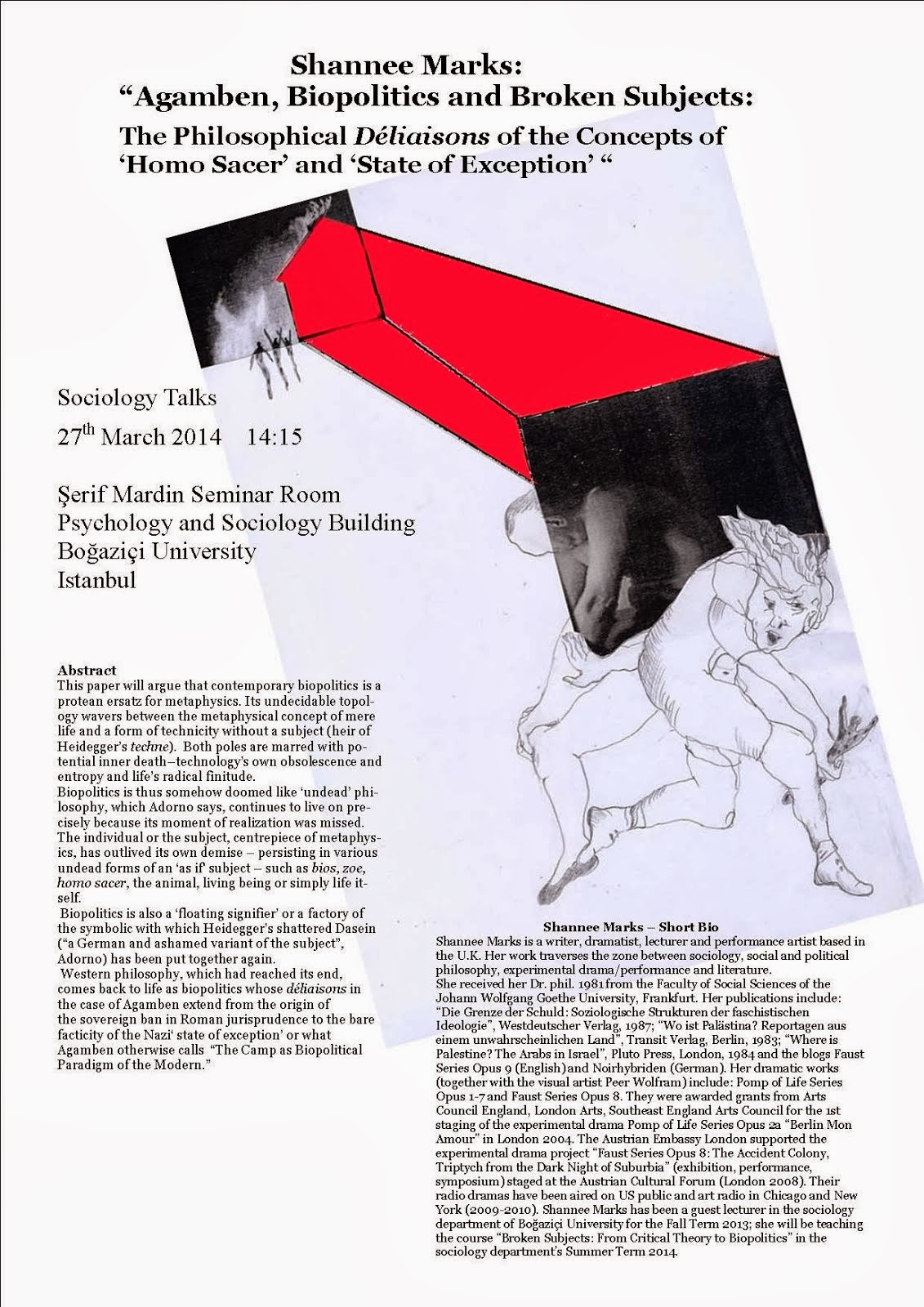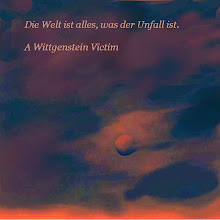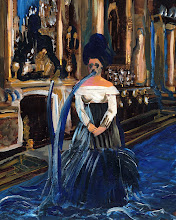4. The Monstrous Site
The maitre of topologies is very good at disguising them – they are protean and polymorphous and more or less invisible in constant metamorphosis. A vortex of topologies or strategies and counter-strategies. As he writes in Broken Hegemonies – how is one to live under the sign of Proteus? (Broken Hegemonies, Indiana University Press, 2003, p. 514) But then proposes a detour – paraphrasing Heidegger: “Proteus alone can save us now.” (ibid., p. 513) Proteus is one signature of the alchemical for Schürmann – he poses a whole series of similar questions of transformation as a means of flight, evasion and conversion: “Toward what, then, may man transmute himself?” In the chapter on Meister Eckhart transmutation in “the great alchemical work” still means the old alchemical solve et coagula – where the human body and soul are regarded as a metal – capable of becoming liquefied and indistinct so as to be transformed into the noblest singular form of gold. (see ibid., p. 278, p. 280)
Isn’t Schürmann perpetually composing and decomposing his ‘an-archic self’ in his own Birth of Tragedy alias Broken Hegemonies – which he also calls “this monstrous site”?
What is a ‘monstrous site’ – it appears to contain both archic and an-archic determinants which are at war with one another. It is a post-diremptive state resembling a post-apocalyptic landscape. Parts of the broken hegemony still pulse with quasi-life, while the flayed and withered limbs of other hegemonic carcasses are strewn about on the charred ground - the birth of the ‘new’ though is unfinished, nameless – still inchoate, formless hence monstrous. The monstrous site is a warning against itself. It is the condition of being that the diremption of the modern hegemonic fantasm of self-consciousness reveals.
Schürmann following Heidegger also calls this condition simply “Übergang” or transition. It places us in transit - makes us into transitional beings. But Schürmann cannot say in transit from where or where to – not even which transition it is. (Broken Hegemonies, ibid. p. 552)
The monstrous site has no fixed address – it breaks ‘normative principles’ and it is itself fractured time. Schürmann suggests that within the breaking hegemony of consciousness another counter-fracturing takes place of time.
Whatever else it might be – the monstrosity has to do with Heidegger – and his flawed suspicious awakening with pain from a “failed uprising” or “the fault from which Heidegger awakened” (ibid., p. 277).
His pain rings out in the history of being like the cry of a wounded beast down until our own ‘fissured moment’ – the book in which Schürmann reads Heidegger as if it were an intimate confession of his political folly – Beiträge zur Philosophie: Vom Ereignis – is itself a “play of functions and dysfunctions, no longer in ancient or modern texts, but at the level of Heidegger’s utterance itself, (making) this utterance the most pathetic document of broken hegemony.” (ibid., p. 524)
His pain rings out in the history of being like the cry of a wounded beast down until our own ‘fissured moment’ – the book in which Schürmann reads Heidegger as if it were an intimate confession of his political folly – Beiträge zur Philosophie: Vom Ereignis – is itself a “play of functions and dysfunctions, no longer in ancient or modern texts, but at the level of Heidegger’s utterance itself, (making) this utterance the most pathetic document of broken hegemony.” (ibid., p. 524)
It is the vertiginous aspect of Schürmann’s text, its never coming to rest, its staying liquid – that Schürmann-Heidegger stand both inside this shipwreck of broken Nazi hegemony and somewhere outside at an undisclosed other site or distant shore viewing the wreckage from multiple obscure angles. This is Schürmann’s elaborate version of Sophocles’ tragic method – amphinoein – or thinking from two sides. Like the goddess enjoining Parmenides’ kouros – the chorus in tragedy urges the tragic hero: “Young man, hold disparates together (…)” (ibid., p. 38). Schürmann discovers a similar vision in Virginia Woolf – “One thinks of the words of Virginia Woolf: It is fatal for anyone to be a man or woman pure and simple. One must be woman-manly, or man-womanly.” (A Room of One’s Own, 1975, p. 108) (ibid., 639) In everything see the shadow of its opposite:
“In day, see night; in the boy, the girl; in Solon, Alciabiades; in a democratic regime, tyranny; in the right, the left.” (ibid.)
In the case of Heidegger – Schürmann himself acts in the manner of Parmenides as the “one that holds contrary beings together” (hen synechés)” (ibid., p. 67).
One may ask though: how does it come to pass that the long agony of modern consciousness, the history of being itself and its epochality suddenly hinge so exclusively upon one so-called Nazi uprising, its failure and Heidegger’s ensuing disenchantment? Wouldn’t that be making history of being contingent on singular facts even philosophical facts of thinking, a move Schürmann otherwise condemns?
Could it be though that Heidegger’s brutal awakening is not from “having been duped” or from an error or errancy in his political aspirations – rather he awakens to the indifference of this uprising, its contingency, that it failed to interrupt or break into the history or condition of being – leaving this history untouched? As such – at this point Schürmann’s text is riveted to its own inward turning double bind – or the tragic differend of his repulsion from and attraction to Heidegger’s folie de grandeur of errancy – isn’t the ‘monstrous site’ we’re supposedly riveted to - itself a fantasm? And if it is not a fantasm – then it alone in the history of being would be immortal – eluding the pull of the ultimates: the double binded Scylla and Charybdis of natality and mortality. Hence Schürmann’s boast “of what other figure of our century can it be said that 1933 and its aftermath opened his eyes to what there is of being?…” ( see Broken Hegemonies, ibid., p. 527) presumes what it would prove - that “1933 and its aftermath” affects or disrupts the history of being – begging the question if any other 20th century figure other than Heidegger would have had his eyes opened by it.
Yet Schürmann’s ‘holding together’ of Heidegger is tenuous/ambiguous – one has the sensation – he could at any minute let him fall into the grand Abgrund of post-metaphysics. In an almost offhand manner he questions Heidegger’s Beiträge zur Philosophie: “Is so stripping Da-sein of its transcendental structure and singularizing it as ontic tantamount to taking a step back so as to leap further? Leaping onto some post-subjectivist terrain? It seems doubtful. No longer transcendental, phenomenology risks becoming merely descriptive.” (ibid., p. 521)
Yet Schürmann’s ‘holding together’ of Heidegger is tenuous/ambiguous – one has the sensation – he could at any minute let him fall into the grand Abgrund of post-metaphysics. In an almost offhand manner he questions Heidegger’s Beiträge zur Philosophie: “Is so stripping Da-sein of its transcendental structure and singularizing it as ontic tantamount to taking a step back so as to leap further? Leaping onto some post-subjectivist terrain? It seems doubtful. No longer transcendental, phenomenology risks becoming merely descriptive.” (ibid., p. 521)
The parricide/‘destitution’/diremption Schürmann holds ready for Heidegger remains buried, locked in the text. You can take Schürmann out of Heidegger but can you take Heidegger out of Schürmann?
 |
| Carmen Hendershott and the Author at Arnhold Hall, NYC, April 2017 |
 |
| Richard Bernstein and the Author at the New School, NYC, May 2017 |
5. Notes on “Film without Why”
Some philosophers knowingly strive to annihilate their predecessors. Other philosophers bring them back to life. Modernity may see itself in a perpetual momentum of surpassing – but there is always a counter-movement of returning. Schürmann is a philosopher of reversals and turnings and conversions and transmutations what he also refers to as errancy – a random/an-archic method of overcoming the need to surpass. Coming back though is as powerful as surpassing. Deleuze and Guattari ask of those aliens in ancient Greece, the first philosophers known as sophists pouring into Athens from the east – “What sort of stranger is there within the philosopher, with his look of returning from the land of the dead?” – a look stamped on their features from a metanoia d’outre-tombe. (see What is Philosophy?, Columbia University Press, New York, p. 69)
There is no more powerful return than that. In the ancient world it was only the physician god Æsculapius who could perform this cure of resurrection – as he does for Hippolytus in one version of the myth.
 |
| Boris Groys and the Author at Hotel Malmaison, London, July 2017 |
The Greek-American experimental filmmaker Gregory Markopoulos sets his film Twice a Man, his modern soteriological/homoerotic fable of Hippolytus, in the New York City of his day – a decade or so before Schürmann arrived.
Markopoulos himself moved in the opposite direction to Schürmann – born in the US, a son of Greek immigrants he left the United States for his patrimony Greece never to return. Both Schürmann and Markopoulos felt most at home in austere communion with the ancient sites of Greece.
Markopoulos created Eniaios or the One, 22 cycles equaling 80 hours of film screened till this day only at a special outdoor site he called Temenos near his father’s birthplace Lyssaraia in the Peloponnesus. Schürmann spent all his summers in a primitive house on the Greek island Amorgos where he wrote many of his works.
Markopoulos withdrew his films from the archives, restricted screenings to the ‘cult-site’ Temenos – it would seem – in the anachronistic attempt to reverse the ‘decay of aura’ Benjamin describes in his essay The Work of Art in the Age of its Technical Reproducibility. Ideally his images should appear as unique cult-images only to the physically present spectator.
Reiner Schürmann also resisted the decay of aura – in his concept of ‘singularity’. Aura is a function of distance. Even when the material cult object is spatially close - its cult-image is unapproachable. As Benjamin writes: “In fact, Unapproachability is a major quality of the cult-image.” (“In der Tat, ist Unnahbarkeit eine Hauptqualitat des Kultbildes.”, Walter Benjamin, Das Kunstwerk im Zeitalter seiner technischen Reproduzierbarkeit, Walter Benjamin Gesammelte Schriften, I 2, Frankfurt, 1991, S. 480)
Assuming in himself – for his contemporaries – the inviolability of a cult-site – Schürmann is transmuted into his own unapproachable cult-image.
Or in the words of Baudelaire – “J’ai pétri de la boue et j’en ai fait de l’or. Glorifier le culte des images (ma grande, mon unique, ma primitive passion).”
The mythical figure of the god-physician becomes in Twice a Man the artist or filmmaker as physician. He brings Hippolytus back from Hades on the Staten Island Ferry – they become lovers. Markopoulos’ rendering of this myth brings to mind Schürmann’s rite de passage in the New World – where he comes back to life in the New School for Social Research. In Hippolytus and his artist-god lover I see Schürmann and Louis Comtois in their Manhattan bohemian ménage. Lovelorn Phaedra is Hannah Arendt, Theseus, the cruel merciless father is Heidegger (‘the hidden king’) – both are transmuted in Broken Hegemonies into the mother-father pair of ultimates – natality–mortality. Schürmann has his own methods for bringing back the dead.
 |
| Reiner Schürmann's Chair in Madison, New Jersey |
Markopoulos withdrew his films from the archives, restricted screenings to the ‘cult-site’ Temenos – it would seem – in the anachronistic attempt to reverse the ‘decay of aura’ Benjamin describes in his essay The Work of Art in the Age of its Technical Reproducibility. Ideally his images should appear as unique cult-images only to the physically present spectator.
Reiner Schürmann also resisted the decay of aura – in his concept of ‘singularity’. Aura is a function of distance. Even when the material cult object is spatially close - its cult-image is unapproachable. As Benjamin writes: “In fact, Unapproachability is a major quality of the cult-image.” (“In der Tat, ist Unnahbarkeit eine Hauptqualitat des Kultbildes.”, Walter Benjamin, Das Kunstwerk im Zeitalter seiner technischen Reproduzierbarkeit, Walter Benjamin Gesammelte Schriften, I 2, Frankfurt, 1991, S. 480)
Assuming in himself – for his contemporaries – the inviolability of a cult-site – Schürmann is transmuted into his own unapproachable cult-image.
Or in the words of Baudelaire – “J’ai pétri de la boue et j’en ai fait de l’or. Glorifier le culte des images (ma grande, mon unique, ma primitive passion).”
Markopoulos’ simply expressed ontology is “film as film”. Although at least as ancient as Plato’s cave ‘film as film’ is not just a technological species of embalming or mummification – a kind of death mask, arising from an anthropological drive to preserve corporeal mementoes of the dead.
Whatever its form or quality – through the hallucinatory nature of its photographic base and its broken reversible registers of time (even more than in music) – film is inevitably a spectral theatre of the afterlife. But in the hands of the filmmaker-demiurge it has the potential for resurrection.
It relates to philosophy like war in Clausewitz’s doctrine does to politics. Philosophy is the sphere of linguistic discursive negotiation and a certain cacophony – similar to politics. Film follows the laws of action, the sphere in which power is demonstrated – like war. It subverts dialectics – what Nietzsche mocked as Socrates’ plebeian stratagems. Although the spectator is not the enemy – in a certain sense film undermines his capacity to resist film. In Schürmann’s words – it compels him to stop asking why. Film without why – to borrow the vernacular – is itself a condition of being – and like being – it is time, duration, not just in succession, also in its ‘fissuring’.
As bellicose action and real hallucination – film without why needs no other ground than itself – it is self-engendering and escapes the constraints of any metaphysics of causes. For all the wrong sentimental neo-communitarian reasons even Stanley Cavell in The World Viewed is convinced “(…) movies are inherently anarchic.” (World Viewed, Reflections on the Ontology of Film, Cambridge Mass./London, 1979, p. 214)
 |
| Carmen Hendershott and the Author at La Maison du Croque Monsieur, NYC, April 2017 |
How to see though philosophy (in film) not just verbally but eidetically –through the ‘thought-image’ – or the ‘thought-phantasm’? The Phantasmatic is that aspect of film which has expression but no substance. The Real is that aspect which has substance but no expression.
Film is the phantasmatic casing – in which the Real (the expressionless) and the chimera, (the expression)(or as Bazin says, the hallucinatory) together become actual – one with another. Deleuze alludes to this as the ‘crystalline regime’: Like the dead white horse dangling over the river Neva from the raised drawbridge in Eisenstein’s October “(…) the real and the imaginary, the actual and the virtual, chase after another, exchange their roles and become indiscernible.” (Gilles Deleuze, Cinema 2: The Time-Image, London, 2000, p. 127)
Film is the phantasmatic casing – in which the Real (the expressionless) and the chimera, (the expression)(or as Bazin says, the hallucinatory) together become actual – one with another. Deleuze alludes to this as the ‘crystalline regime’: Like the dead white horse dangling over the river Neva from the raised drawbridge in Eisenstein’s October “(…) the real and the imaginary, the actual and the virtual, chase after another, exchange their roles and become indiscernible.” (Gilles Deleuze, Cinema 2: The Time-Image, London, 2000, p. 127)
In film – thought, image and sound (but affect as well) are fused in the cinema frame - and in the pores of this apparently indivisible frame lurk ‘the powers of the false’. No film can tell you when to look away. For every world viewed there is an equal and opposite world unviewed.
Film as such is an inimitable medium to theatricalize philosophy. Even more in Schürmann's case – he dared to live a dramatic experimental life, as a ‘Byronic hero’: “among them, but not of them; in a shroud of thoughts which were not their thoughts (…)” (Childe Harold). Or in what Nietzsche calls a “noble” (vornehm) fashion: “that one perpetually contradicts the many not through words but actions.”
Our film shows glimpses of the drifting shipwreck of Reiner Schürmann’s mystery – “partly destructive, partly ironic”.
✦ The Unapproachable Reiner Schürmann - A Phantasmatic Philosopher: Film Without Why (Parts 1-3) is an expanded version of our film project presentation and trailer premiere at the Reiner Schürmann Colloquium, Espace diaphanes, Berlin, November 2nd 2017.
Acknowledgements: Many thanks to Mark Theunissen, New School for Social Research, for his photographs of Broadway, Lower Manhattan and the Louis K. Meisel Gallery. Sources of the Reiner Schürmann photographs are www.presocratics.org and the Reiner Schürmann Papers in the New School Archives, NYC. We are extremely grateful to the archivists Wendy Scheir and Jeanne Swadosh for their kind help and expert guidance through the maze of the Schürmann papers.
The 'Resurrection Screen' is from Jean Luc Godard, Histoire(s) du Cinéma, Part 1. Source of the historical photos of the German capitulation is Eva Berthold, Kriefsgefangene im Osten, Königstein/Ts., 1981
Lamarchefunèbre is from Libération: Livres, 1st February 2001.
The 'Resurrection Screen' is from Jean Luc Godard, Histoire(s) du Cinéma, Part 1. Source of the historical photos of the German capitulation is Eva Berthold, Kriefsgefangene im Osten, Königstein/Ts., 1981
Lamarchefunèbre is from Libération: Livres, 1st February 2001.
© Shannee Marks and Peer Wolfram, Ulysses Productions, November 2017



































